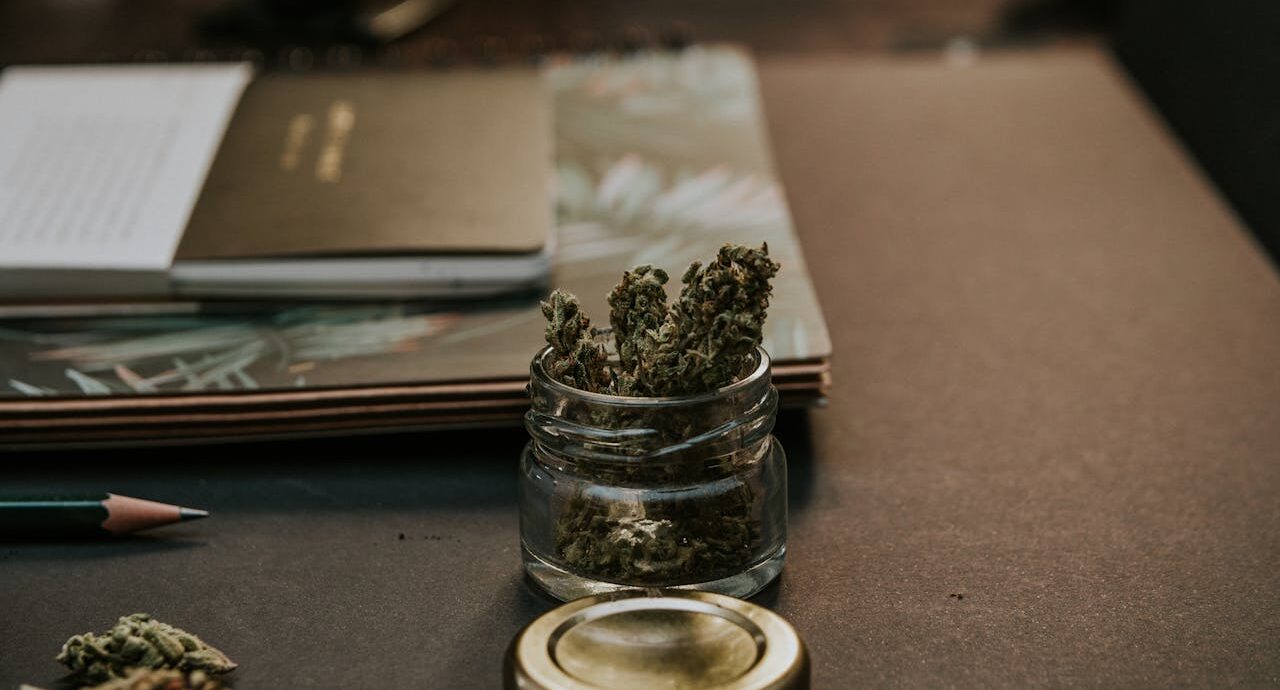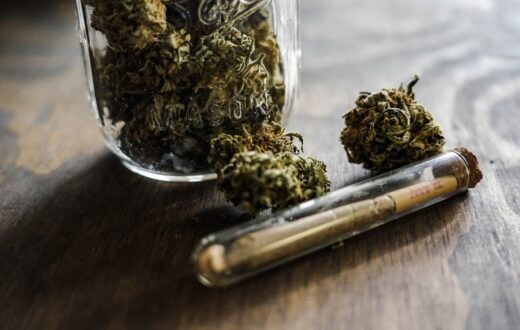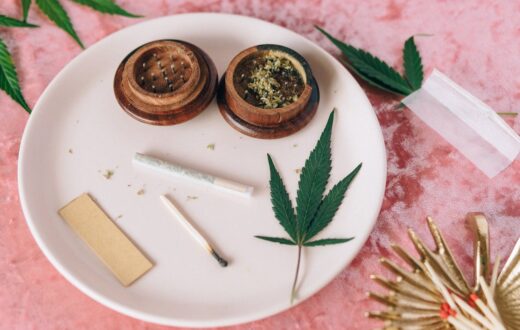Introduction to Bubba Kush Autoflower
Bubba Kush Autoflower is a highly regarded cannabis strain that captivates both novice and experienced growers alike. This strain has its roots firmly planted in the genetics of the original Bubba Kush, which is known for its indica-dominant properties. The autoflower variant has been created through selective breeding, incorporating ruderalis genes, which allow the plant to flower automatically, irrespective of light cycles. This trait makes Bubba Kush Autoflower particularly appealing for cultivators who may not have the ability to manipulate lighting schedules.
One of the standout features of Bubba Kush Autoflower is its distinctive flavor profile, which combines earthy undertones with hints of sweet chocolate and coffee. The aromatic experience is complemented by a smooth smoke that leaves an enticing aftertaste, making it a favorite among cannabis connoisseurs. The strain’s potency typically ranges between 18% to 22% THC, delivering a well-rounded high that provides relaxing effects, often accompanied by euphoric feelings, which can help alleviate stress and anxiety.
Additionally, Bubba Kush Autoflower is celebrated for its remarkable yield potential. With optimal conditions, growers can expect generous harvests in a relatively short period, typically within 8-10 weeks from germination to harvest. This fast turnaround is particularly advantageous for those looking to maximize their yield in limited timeframes. Furthermore, Bubba Kush Autoflower is known for being beginner-friendly due to its resilient nature. This strain can thrive in various environments, whether grown indoors or outdoors, making it an ideal choice for individuals seeking to learn how to grow Bubba Kush Autoflower successfully.
Understanding Autoflowering Cannabis
Autoflowering cannabis strains, such as the Bubba Kush autoflower strain, represent a significant innovation in the world of cultivation. The primary distinction between autoflower and photoperiod strains lies in their growth cycle. Autoflowering plants, unlike photoperiod strains, automatically switch from the vegetative stage to the flowering stage based on age rather than light cycles. This unique characteristic arises from their genetic lineage, predominantly derived from the Cannabis ruderalis species, which has adapted to various climates by developing these advantageous traits.
The growth cycle of an autoflowering strain typically spans 8 to 12 weeks from seed to harvest. This rapid turn-around appeals to many growers, particularly those in regions with shorter growing seasons. The Bubba Kush autoflower strain exemplifies this efficiency, allowing cultivators to maximize yields in a limited timeframe. In addition to their resilient nature, autoflowering plants often possess a more compact form, making them particularly suitable for small spaces or discreet cultivation setups.
Despite their advantages, there are common misconceptions surrounding autoflowering cannabis. One prevalent belief is that these strains yield less than their photoperiod counterparts. While it is true that autoflowering plants may have smaller yields in some cases, factors such as genetics, environment, and care can greatly influence outcomes. Additionally, new cultivars have been developed that can yield comparably to traditional strains. Understanding these nuances and benefits is essential for growers seeking to tap into the potential of strains like Bubba Kush autoflower. By appreciating the science behind their growth cycles and dispelling myths, cultivators can make informed decisions for their gardening endeavors.
Ideal Growing Conditions for Bubba Kush Autoflower
To successfully cultivate the Bubba Kush autoflower strain, understanding its ideal growing conditions is paramount. These conditions encompass several critical factors, including temperature, humidity, light, soil preferences, nutrients, and water needs. Each of these elements plays a vital role in fostering vigorous growth and optimizing the plant’s yield.
Temperature is one of the first considerations when learning how to grow Bubba Kush autoflower strain. Ideally, the daytime temperatures should range between 70°F to 80°F (20°C to 27°C) while the nighttime temperatures can dip slightly lower, ideally between 60°F to 70°F (15°C to 21°C). Maintaining these temperature ranges ensures that the plant remains healthy and active throughout its growth cycle.
Humidity levels also significantly impact the development of the Bubba Kush autoflower. During the vegetative stage, it thrives in humidity levels of 40% to 60%. However, as the plant transitions into the flowering stage, lowering humidity to around 40% is essential to prevent mold and bud rot, which can severely affect the yield.
Lighting is crucial in the cultivation of this strain. Bubba Kush autoflower requires at least 18 hours of light daily to achieve optimum growth. Whether using natural sunlight or artificial grow lights, ensuring consistent light exposure helps to maximize photosynthesis. When setting your grow lights, it is wise to maintain a distance of approximately 24 to 30 inches from the plants to avoid light burn.
Soil preferences for Bubba Kush autoflower should include well-draining soil enriched with organic matter. Nutrients play a crucial role, particularly nitrogen during the vegetative phase and phosphorus and potassium during flowering. Lastly, appropriate watering techniques—maintaining a balance between dryness and wetness—are vital to prevent root rot while ensuring the plant receives enough moisture to thrive. By adhering to these ideal growing conditions, you can enhance your chances of a successful harvest with the Bubba Kush autoflower strain.
Germination and Seedling Stage
The germination and seedling stage plays a crucial role in how to grow Bubba Kush autoflower strain successfully. This stage begins with the selection of high-quality Bubba Kush autoflower seeds, which should display a strong appearance, with a dark color and a firm texture. The initial step is to germinate the seeds, and there are several effective methods you can employ.
One popular method is the paper towel technique. To use this method, moisten two paper towels and place them on a plate. Then, position the Bubba Kush seeds between the towels, ensuring they are not touching each other. Cover the seeds with another damp towel and place the plate in a warm, dark area. Check daily for moisture and within a few days, you should see small taproots emerging from the seeds.
Another option is direct planting in the soil. For this method, fill a small pot with a quality seed-starting mix and plant the seeds about half an inch deep. Water them gently, keeping the soil moist but not saturated, and place the pot in a warm area under grow lights or sunlight to stimulate growth. Once the seeds sprout, transfer them carefully into larger pots to accommodate the developing roots.
After germination, the seedling stage requires careful nurturing. Provide ample light for 18-24 hours a day and ensure temperatures remain stable between 70-80°F (21-27°C). Humidity levels should be around 65-70% to prevent stress. Implementing a gentle watering schedule, where the top inch of soil dries out between waterings, can support healthy root development. Adequate care during this early stage is essential to ensure robust growth, with seedlings transitioning smoothly into the vegetative phase of the Bubba Kush autoflower strain’s lifecycle.
Vegetative Phase Management
The vegetative phase is a critical stage in the life cycle of the Bubba Kush autoflower strain, typically lasting about 3 to 6 weeks, depending on environmental conditions and the grower’s preferences. This phase is vital for establishing a robust foundation for future flower production. During this period, the plant focuses on developing foliage and root systems, making it essential to provide optimal conditions for growth.
To promote healthy plant development during the vegetative phase, growers should ensure that plants receive adequate light. Ideally, a light schedule of 18 to 24 hours of light per day during this phase will encourage vigorous growth. As an autoflowering strain, Bubba Kush has a genetic predisposition to transition into the flowering phase without a change in light schedule, but maximizing light exposure enhances overall health.
Nutrient management is another crucial aspect of vegetative phase management. It’s essential to provide a balanced nutrient mix that includes nitrogen, phosphorus, and potassium, with an emphasis on nitrogen during this stage to foster lush, green growth. Watering practices should also be consistent, ensuring that the soil is kept moist but not overly saturated to prevent root rot.
Training techniques can further optimize the growth of the Bubba Kush autoflower strain. Techniques such as low-stress training (LST) can help promote an even canopy and enhance light penetration, while topping the plants can encourage bushier growth. Proper training not only maximizes yield potential but also prepares the plants for a successful transition into the flowering phase.
In summary, effectively managing the vegetative phase of the Bubba Kush autoflower strain involves providing adequate light, balanced nutrients, and employing training techniques. Adopting these practices will ensure that your plants are well-prepared for the impending flowering stage, ultimately leading to a healthier yield.
Flowering Phase and Harvesting
The flowering phase of the Bubba Kush autoflower strain is a crucial period that significantly influences both the yield and potency of the final product. Understanding how to recognize the appropriate time for harvesting is essential for growers seeking to maximize their results. Typically, the flowering phase begins approximately four weeks after germination and can last between eight to ten weeks, depending on various factors such as growing conditions and genetics.
As the plants transition into the flowering stage, several noticeable changes occur. First, the buds will start to swell and become denser, exhibiting a lush appearance that signals healthy growth. During this time, growers should closely monitor the color of the pistils, which will initially appear white or clear and later darken to a reddish-brown hue. A significant indicator that it is nearing time for harvest is that approximately 70-80% of the pistils will have changed color and curled inwards.
In addition to monitoring the pistils, examining the trichomes is critical for determining harvest time. These small, crystal-like structures present on the buds contain the cannabinoids and terpenes responsible for the strain’s potency and aroma. Using a jeweler’s loupe or microscope, growers should check the trichomes’ color; they typically transition from clear to milky white, and then eventually to amber as they mature. A high concentration of milky white trichomes with some amber indicates that the Bubba Kush autoflower strain is at peak potency, blending both high THC levels with a suitable terpene profile.
In essence, recognizing these signs during the flowering phase is vital for growers seeking to harvest Bubba Kush autoflower at the optimal time, ensuring a robust yield and satisfying effects for consumers. Careful monitoring and patience during this phase can reward growers with a bountiful harvest that showcases the strain’s full potential.
Common Challenges and Solutions
Growing the Bubba Kush autoflower strain presents several challenges that every cultivator may face. Being aware of these obstacles, including pests, diseases, and nutrient deficiencies, is essential for a successful growing experience. By identifying these issues early and implementing practical solutions, growers can ensure healthier plants and a better yield.
One of the most common challenges is the presence of pests such as spider mites, aphids, and whiteflies. These pests can severely impact the quality and yield of your Bubba Kush plants. To combat these unwanted invaders, it is recommended to regularly inspect your plants and keep the growing area clean. Natural remedies, like introducing beneficial insects such as ladybugs or using neem oil, can effectively deter pests without harming the plants. Additionally, an integrated pest management (IPM) strategy may help maintain a pest-free environment.
Diseases can also pose a significant threat to the growth of the Bubba Kush autoflower strain. Fungal infections, like powdery mildew and root rot, commonly affect cannabis plants. To prevent these issues, ensure proper air circulation and maintain an optimal humidity level, ideally between 40-60%. If a disease does occur, removing infected plant material and utilizing fungicides can assist in controlling the spread while promoting recovery.
Nutrient deficiencies present another challenge that growers must navigate. Common deficiencies in cannabis include nitrogen, phosphorus, and potassium imbalances. To avoid nutrient-related issues, it is essential to follow a balanced feeding schedule tailored to the specific needs of Bubba Kush autoflower plants. Soil testing can help identify deficiencies, allowing for timely corrections. Regular monitoring and adjustments will keep your plants thriving and increase the chances of a successful harvest.
Understanding these common challenges and implementing effective solutions will enhance your ability to grow the Bubba Kush autoflower strain, resulting in a bountiful yield and satisfying experience.
Post-Harvest Care and Curing
Post-harvest care is crucial in maximizing the quality and potency of the Bubba Kush autoflower strain. After harvesting the buds, handling and processing them with care can significantly influence the flavor and effects of the final product. The first step in this process is proper drying. To begin, cut the branches containing the buds and hang them upside down in a dark, well-ventilated space. Aim for a temperature between 60°F to 70°F (15°C to 21°C) with a humidity level around 50% to 60%. It’s recommended to avoid direct sunlight as it can degrade cannabinoids and terpenes, impacting the strain’s potency and aromatic qualities.
Drying typically takes about 7 to 14 days. You will know the buds are ready when stems snap rather than bend. Once properly dried, the next phase is curing, which can significantly enhance the flavor profile and smoothness of the smoke. For curing, transfer the dried buds into glass jars, filling them only about 70% full to allow air circulation. Seal the jars and store them in a cool, dark place. The curing process should start with opening the jars for about 5 to 10 minutes each day, known as “burping,” which allows excess moisture to escape and fresh air to circulate. Continue this process for at least two weeks, but it can extend up to several months for more complex flavors.
As you learn how to grow Bubba Kush autoflower strain effectively, remember that patience is key during the curing phase. This waiting time can substantially improve the quality of your final product, making it a vital part of the growing cycle. By adhering to these post-harvest techniques, you can ensure that your Bubba Kush buds are not only powerful but also deliver an enjoyable and flavorful experience. Investing time in the drying and curing process will ultimately reward you with the full potential of this exceptional strain.
Conclusion and Final Tips
In conclusion, growing the Bubba Kush autoflower strain can be a rewarding experience for both novice and experienced cultivators. This strain is known for its robust genetics, shorter growing cycle, and an array of delightful flavors and effects. To successfully cultivate this particular strain, understanding the optimal growing conditions, such as temperature, humidity, and light cycles, is crucial. Utilizing high-quality soil and providing adequate nutrients will help your plants thrive and maximize yields.
When learning how to grow Bubba Kush autoflower strain, it is beneficial to experiment with various growing techniques. Techniques like topping, training, and the Screen of Green (SCROG) method can enhance the overall growing process. These methods not only optimize space but also allow for light penetration and airflow, leading to healthier plants. Moreover, regular monitoring of the plants will help in identifying issues such as pests or nutrient deficiencies early on, ensuring timely interventions.
Moreover, engaging with the cannabis community can greatly enrich your growing experience. Sharing insights and learning from the experiences of other cultivators allows for the exchange of valuable tips and tricks that can dramatically improve your results. Don’t hesitate to document your growing journey and share it with others; this can inspire fellow growers and contribute to a broader understanding of how to achieve the best possible cultivation of the Bubba Kush autoflower strain.
By embracing experimentation and staying informed, growers can unlock the full potential of this admirable strain. Remember that each growing experience is unique, providing opportunities to refine techniques and innovate for future grows. Happy cultivating!












